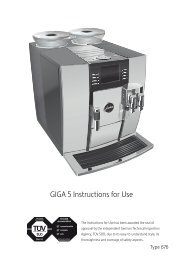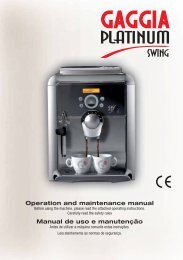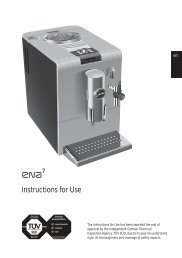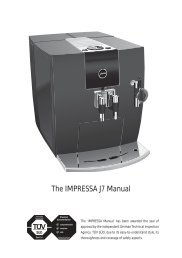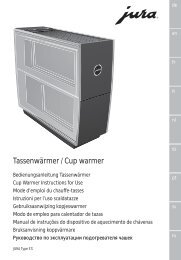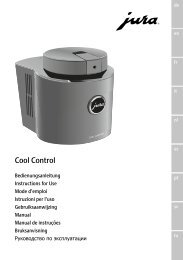Manual tehnic automate cafea Saeco Group 200
Manual tehnic automate cafea Saeco Group 200
Manual tehnic automate cafea Saeco Group 200
Create successful ePaper yourself
Turn your PDF publications into a flip-book with our unique Google optimized e-Paper software.
- Automatic Error Reset<br />
Simplified mode (for technical unskilled<br />
personnel) for error reset that, when<br />
implemented, tries to remove any non-critical<br />
error condition in the VM operation<br />
Starting the Error Reset Procedure<br />
The error-reset procedure is started by pressing<br />
both the P1 ‘Programming’ and P2 ‘Maintenance’<br />
simultaneously for at least 5 seconds - see fig<br />
40, ref 1 and ref 2<br />
A beep signals the procedure start<br />
Reset Procedure in Absence of Errors<br />
If no failure is present, the display shows the<br />
message ‘Ok - 0/0’ The user can go back to the<br />
standard mode by pressing ENTER<br />
In this way, a quick system check-up by the<br />
operator is also assured<br />
Reset Procedure in Presence of Errors<br />
In presence of errors the procedure consists of<br />
two phases:<br />
1 Error list;<br />
2 Error removal (attempt to remove)<br />
1- Error list<br />
The VM displays a list of errors detected The<br />
first line of the display indicates the total number<br />
of errors ‘ERRORS XX’<br />
The second one displays their descriptions on<br />
one or more screens This list shows current<br />
error or trouble messages: Each message is<br />
displayed on a single screen page containing<br />
their descriptions, for example: ‘NO WATER 01’<br />
The user can pass to the following screen page<br />
by pressing ENTER<br />
By pressing ENTER again after viewing the last<br />
screen, the user will remove the errors<br />
2 - Error removal (attempt to remove)<br />
English<br />
The VM tries, in sequential order, to remove the<br />
errors automatically During this phase the error<br />
subject to the reset procedure is displayed;<br />
In the second line of the display there is a ‘status<br />
bar’: the bar elements are made by points (“”)<br />
At the end of each attempt the display shows<br />
the message Ok/Fail and then proceeds with the<br />
following step<br />
If, at the end of the sequence, all the errors have<br />
been removed, the reset has been carried out<br />
successfully; otherwise - if one or more errors<br />
could not be removed - it failed<br />
Successful Reset<br />
The VM shows the message ‘ Ok - N/N’ with a<br />
long single beep<br />
N indicates the number of errors removed<br />
The vending machine is reset by pressing the<br />
ENTER key<br />
Reset failed<br />
If, at the end of this procedure, at least one error<br />
condition remains unchanged, the display will<br />
show the message ‘Fail X/N’ where X is the<br />
number of errors that could not be removed and<br />
N the total number of errors detected<br />
The message is accompanied by some short<br />
beeps<br />
The vending machine is reset by pressing the<br />
ENTER key<br />
- Error Log<br />
The VM stores in its internal storage significant<br />
incidents occurring in the VMC (for example<br />
errors, trouble signals etc)<br />
The storage takes place at the detection of the<br />
error condition and consists in storing the<br />
following information:<br />
1 error or failure code<br />
2 location of the signal source<br />
3 day, month, hour and minute of the error<br />
detection - this information is given only if the<br />
VM is equipped with a timekeeper<br />
The information is included in a list that can<br />
contain up to 50 elements, over that limit the<br />
information is stored starting by position 1<br />
(previous information will be lost)<br />
43



